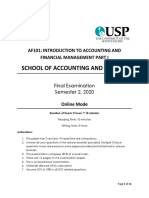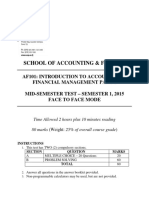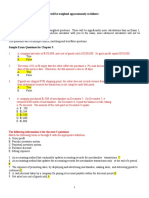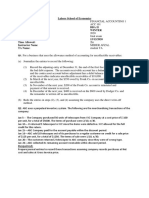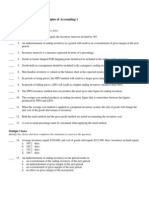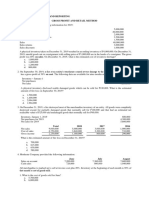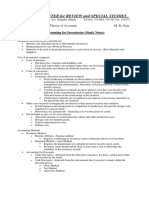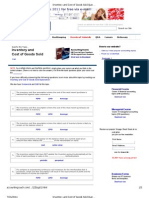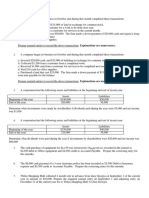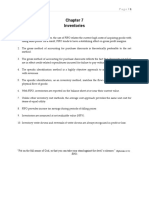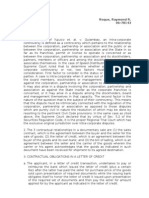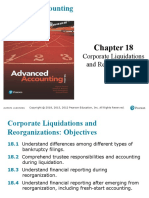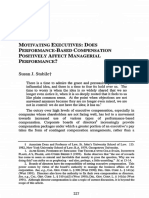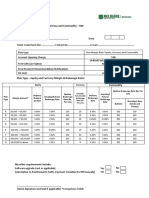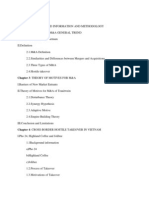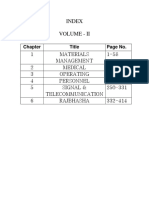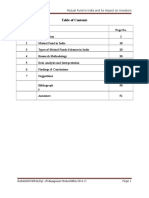Prof.
Zain Shakoor
Lecturer UCP (Accounting & Finance)
Final Term
Introduction to Financial Accounting
(BAAC-1203)
Practical exercises
Topic 1: Inventory valuation: FIFO and LIFO under provision IAS-2
Question: 1
Suppose Greg‟s Tune, Inc., has the following inventory records for the month of July 2019.
Date Items Units Unit cost Price
July 1st Beginning balance 100 8
July 10th Purchase 60 9
July 15th Sale 70 -
July 21st Purchase 100 10
July 30th Sale 90 -
Required:
Prepare „‟Perpetual Inventory Cards‟‟ and calculate ending balance of inventory at the end of
July and cost of goods sold for the whole month of July by using the following methods:
1. FIFO (First-in-First-out)
2. ACM (Average Costing Method)
3. LIFO (Last-in-First-out)
Question: 2
Neil.Com uses perpetual inventory system for its inventory accounting. Following data for the
month of April given below. Prepare perpetual inventory cards by using the following methods.
1) FIFO 2) ACM 3) LIFO
Date Items Quantity @ P.U Cost
April 8 Purchase 42 units @ 20 each
April 14 Sale 35 units
April 20 Purchase 20 units @ 24 each
April 24 Purchase 10 units @ 30 each
April 27 Sale 30 units
1
�Question: 3
Express Lane Inc. uses the following methods to record its inventory (FIFO, LIFO, and ACM).
Prepare perpetual inventory cards for the month of November.
Date Items Quantity Per Unit
Nov 1st Balance 17 68
Nov 6th Sale 7 -
Nov 8th Purchase 20 74
Nov 17th Sale 20 -
Nov 30th Sale 4 -
Question: 4
On January 15, 2005, a company sold 1000 units of merchandises. Prior to the sale, the
company‟s perpetual inventory records for the units purchased as follows:
Purchase Date Quantity Unit Cost Total Cost
Dec. 12, 2004 600 $29 $17,400
Jan. 9, 2005 900 32 28,800
Total on hand 1500 $46,200
Instructions:
a) Complete a subsidiary ledger record for the merchandise using each of the four inventory
valuation methods listed below in part b. your inventory records should show both
purchases of this product, the sale on January 15 and the balance on hand at December
12, January 9 and January 15.
b) Prepare a separate journal entry to record the cost of goods sold relating to January 15
sale of 1000 units under the following assumptions:
1) Specific identification method (500 units sold were purchased on December 12, and the
remaining 500 were purchased on January 9).
2) Average cost method
3) FIFO
4) LIFO
c) Which method is suitable for “financial reporting purpose” and for “tax purpose”?
Question: 5
(Periodic Inventory System)
Mach IV Audio uses periodic inventory system. One of the stores most popular products is a
minidisc car stereo system. The inventory quantities, purchases and sales of this product for the
most recent year are as follows:
2
� No. of units Cost per unit Total cost
Inventory Jan. 1 10 $299 $2,990
1st purchase (May. 12) 15 306 4,590
2nd Purchase (July. 9) 20 308 6,160
3rd purchase (Oct. 4) 8 315 2, 520
4th purchase (Dec. 18) 19 320 6,080
=Goods available for sale 72 22,340
- Units sold (51)
Inventory, Dec. 31 21
Instructions:
Using periodic inventory system, compute the cost of the December 31 inventory and the cost of
goods sold for the minidisc systems during the year under each of the following cost flow
assumptions:
1. FIFO
2. LIFO
3. Average Cost/ Moving Average
Question: 6
Pemberton Products uses a periodic inventory system. The company‟s records show the
beginning inventory on January 1, and the purchases during the current year to be as follows:
Units @ Total Cost
Jan.1 Beginning inventory 9 3.00 27
Feb. 23 Purchase 12 3.50 42
Apr. 20 Purchase 30 3.80 114
Ma 4 Purchase 40 4.00 160
Nov. 30 Purchase 19 5.00 95
Totals 110 438
A physical count indicates 20 units in inventory at year-end. Determine the cost of the ending
inventory, based on each of the following methods of inventory valuation.
Instructions:
a) Average Cost/ Moving Average
b) FIFO
c) LIFO
d) Which of the above methods (if any) results in the same ending inventory valuation under
both periodic and perpetual costing procedures? Explain.
3
� Topic 2: Accounting for a merchandising business
Question: 1 By using the following operating and financial information of Alpha merchandising
company, you are required to prepare income statement for the year ended December 31, 2010.
Sales 900,000 Cost of Goods Sold 540,000
Wages expense 150,000 Advertising expense 6,800
Insurance expense 9,600 Utilities expense 6,400
Office supplies expense 1,700 Depreciation expense 58,600
Income tax expense 36,000 Accounts Receivable 12,000
Question: 2 By using the following operating and financial information of Alpha merchandising
company, you are required to prepare income statement for the year ended December 31, 2010.
Sales 900,000 Cost of Goods Sold 40% of net sales
Sales returns 1,500 Sales discounts 1,000
Wages expense 150,000 Advertising expense 6,800
Insurance expense 9,600 Utilities expense 6,400
Office supplies expense 1,700 Depreciation expense 58,600
Income tax expense 40% Accounts Receivable 12,000
Accounts payable 20,000 Interest expense 2,000
Question: 3 Compute the cost of goods sold of merchandising company by using the following
information:
1. The inventory on hand at the end of the year 2004 cost $14,000.
2. During 2005, purchases of merchandise for resale to customers totaled $130,000 with
purchases returns 2,000.
3. Inventory on hand at the end of the year 2005 cost $12,000.
Question: 4 Following data are relating to the operating and financial items of ABC
Merchandising Company for the year ended 31st December, 2011. Prepare Merchandising
income statement for the year ended 31st December, 2011.
Sales revenue 50,000
Operating expenses
Admin expenses 6000
Marketing expenses 2000
Cost of goods sold (20% of sales)
Cash 10,000
Interest expense 5,000
Tax rate 40%
Salary payable 7,000
4
�Question: 5 Alpha Merchandising Company starts its operations last year. Its financial data for
that period are as follows. Calculate its financial result by preparing income statement for the
year ended 31st December, 2019.
Units sold 10,000
Per unit sale price 10 each
Operating expenses
Admin expenses 5000
Marketing expenses 5000
Depreciation expense 2,000
Cost of goods sold 65,000
Land 80,000
Interest expense 4,000
Tax rate 40%
Question: 6 Hendry‟s Boutique is a retail clothing store for women. Shown below is the stores
adjusted year-end trial balance dated December 31, 2005.
Hendry’s Boutique
Adjusted Trial Balance
December 31, 2005
Dr. Cr.
Cash 15,200
Accounts Receivable 2,600
Merchandise Inventory 17,500
Prepaid Rent 1,800
Office Supplies 900
Office Equipment 41,000
Accumulated Depreciation-Office Equipment 12,000
Accounts Payable 12,750
Sales Tax Payable 3,200
Capital Stock 18,000
Retained Earnings 21,050
Sales 226,000
Sales returns and allowances 2,500
Cost of goods sold 100,575
Purchase discount lost 250
Utilities expense 4,120
Office supply expense 520
Depreciation expense: Office equipment 2,750
Rent expense 6,100
Insurance expense 900
Salaries expense 88,095
Income tax expense 8,190
Total 293,000 293,000
5
�Instructions:
a) Prepare an income statement for the company dated December 31, 2005.
b) Compute the stores gross profit margin as a percentage of net sales.
c) The store reports sales taxed payable of $3,200 in its adjusted trial balance. Explain why
it does not report any sales tax expense.
d) Which accounts appearing in the stores adjusted trial balance comprise its operating
cycle?
Topic 3: Accounting for uncollectable accounts
Estimates of credit losses or bad debts losses (uncollectible) by:
1) Income Statement approach (Percentage-of-sales method)
2) Balance Sheet approach (Percentage-of-Accounts receivables/Aging method)
Example: Calculate the amount of allowance of uncollectible?
Total sales = 100,000
Cash sales = 60,000
Accounts receivables = 55,000
Allowance for uncollectible/ Allowance for doubtful debts = 5%
Question: 1
Journalize the following transactions in the books of Gregs Tunes if company uses the 1)
Allowance method and 2) Direct Write-off method.
a) Sales are made on-account 15,000.
b) Creating a pool of Allowance for uncollectible @ 2% of sales (adjustment).
c) Collected cash from customers 12000.
d) A customer did not pay the cash of $200.
e) Greg Tunes recovered the previously written-off accounts receivables 200.
Question: 2
The accounts receivable balance for Winter Retreats at December 31, 2011, was 18000. During
2012, company completed the following transactions:
a) Sales revenue on-account 447,000.
b) Cash collections 424,000.
c) Actual bad debts occur 5900.
d) Created allowance for bad debts @ 2% of credit sales (adjustment)
Required: Journalize the transactions by using the following two methods: 1) Allowance
method and 2) Direct write-off method
6
�Question: 3
At January 31, 2012, Petersons Accounts receivables totaled 15,000. During February, he earned
revenues of 18,000 and collected cash of 19,000. He also created an allowance of 3% of bad
debts. He also writes-off uncollectible of 1800 on February 29, 2012. But, in March, he has
recovered 1800 uncollectible previously written-off.
Journalize the following transactions in the books of the company by both methods (Allowance
and Direct write-off).
Question: 4
An Aging Schedule for the accounts receivable of Valley Ranch Supply is given below:
Valley Ranch Supply
Analysis of Accounts Receivable by Age
December 31, 2005
Customers Total Not yet 1-30 days 31-60 days 61-90 days Over 90
due past due past due past due days past
due
A $9000 9000
B 2400 2400
C 4000 3000 1000
D 1600 600 1000
E 13000 7000 6000
F 70,000 32000 22000 9600 2400 4000
Totals 100,000 51,000 29,000 12,000 3000 5000
a) Calculate an estimated dollar amount of uncollectible accounts at December 31, 2005 by
using the following percentages of estimated uncollectible:
Not yet due = 1%
1-30 days past due = 3%
31-60 days past due = 10%
61-90 days past due = 20%
Over 90 days past due = 50%
b) If the allowance for doubtful accounts before adjustment at December 31 showed a credit
balance of $4000, prepare the adjusting entry needed to bring the allowance for doubtful
accounts to the proper amount
7
�Question: 5 A company uses the „‟balance sheet approach‟‟ to estimate uncollectible accounts
expense. At year-end an aging of the accounts receivable produced the following five groupings:
Groups Aging Time Debtor Value Estimated % of
Uncollectible
1 Not yet due 500,000 1%
2 1-30 days past due 210,000 3%
3 31-60 days past due 80,000 10%
4 61-90 days past due 15,000 20%
5 Over 90 days past due 30,000 50%
Total 835,000
The allowance for doubtful accounts before adjustment at December 31 showed a credit balance
of $11,800.
a) Compute the estimated amount of uncollectible accounts based on the above
classification by age groups.
b) Prepare the adjusting entry needed to bring the allowance for doubtful accounts to the
proper amount.
c) Assume that on January 10 of the following year, the company learned that an account
receivable that had originated on September 1 in the amount of 8,250 was worthless
because of the bankruptcy of the client. Prepare the journal entry required on January 10
to write-off this account.
d) The firm is considering the adoption of a policy whereby clients whose outstanding
accounts balance become more than 60 days past due, will be required to sign an interest-
bearing note for the full amount of their outstanding balance. What advantages would
such a policy offer?
Topic 4: Depreciation: Straight line depreciation and Declining balance
method
Question: 1 Following data are available about the plant asset (machine) which was purchased
on 1st January 2001:
Purchase price of machine = 16,000
Import duty paid = 1000
Estimated scrap value = 2000
Estimated useful life = 5-years
Required: Prepare a depreciation schedule from 2001-2005, showing depreciation expense each
year, accumulated depreciation and book value at the end of each year by using the following
methods:
1. Straight-line method
2. Declining-balance method
8
�Question: 2
On 1st January 2011, ABC Inc., purchases a truck for 41,000 with an estimated useful life of 5-
years. Its estimated scrap value is 1000. Prepare depreciation schedule by using the following
methods:
1. Original cost method
2. Reducing balance method
Question: 3 At the beginning of the 1st year, Alaska Airline purchased a used airplane for
43,000,000. It expects the plane to remain useful for 5-years and to have a residual value of
7,000,000.
1. Compute Alaska Airline annual depreciation expense, accumulated depreciation and
book value at the end of each 5-year by preparing a depreciation table starlight line
method.
2. Prepare depreciation schedule by using „‟Units-of-Output‟‟ method, if estimated life of
the plane in terms of output (miles) is 4,000,000 miles and the company used the plane by
covering its miles as:
1st year = 14, 00,000 miles
2nd year = 10, 00,000
3rd year = 15, 00,000
4th year = 50,000
5th year = 50,000
Question: 4 Joe Fried Chicken bought equipment on Jan 2, 2012 for 39,000. The equipment was
expected to remain in service for four years and is expected to perform 11000 fry jobs. Its
estimated residual value is 6000.
The equipment performed 1100 jobs in 1st year, 3300 jobs 2nd year, 4400 jobs in 3rd year and
2200 jobs in the 4th year. Prepare a schedule of depreciation each year under each of the
following methods:
1. Straight-line method
2. Declining balance method
3. UOP method
Question: 5
Swanson & Hiller Inc., purchased a new machine on September 1, 2004, at a cost of $108,000.
The machines estimated useful life at the time of the purchase was 5-years, and its scrap value
was 8000.
Instructions:
a) Prepare a complete depreciation schedule, beginning with calendar year 2004, under each
of the methods listed below:
9
� 1. Straight-line method
2. Declining balance
b) Which of the methods is most common for financial reporting purposes?
c) Assume that the company sells the machine on December 31, 2007, for $28,000 cash.
Compute the resulting gain or loss from this sale under each of the depreciation methods
used in part a.
Question: 6 Smart Hardware purchased new shelving for its store on April 1, 2005. The asset is
expected to have a 20-year life and no residual value. The following expenditures were
associated with the purchase:
Cost of the shelving = $12,000
Freight charges = 520
Sales tax = 780
Installation of shelving = 2700
Cost to repair shelf damaged during installation = 400
Requirements:
a) Compute depreciation expense for the year 2005 to 2008 under each depreciation method
listed below:
1. Straight-line, with fractional years rounded to the nearest month.
2. Declining-balance method with fractional years rounded to the nearest month.
b) The company has two conflicting objectives. Management wants to report the highest
possible earnings in its financial statements, yet it also wants to minimize its taxable
income reported to IRS. Explain how both objectives can be met?
c) Which of the depreciation methods applied in part a resulted the lowest reported book
value at the end of the year 2008?
d) Assume that the company sold the old shelving that was being replaced. The old shelving
had originally cost 9000. Its book value at the time of sale was 400. Record the sale of the
old shelving under the following conditions:
The shelving was sold for 1200 cash.
The shelving was sold for 200 cash.
Question: 7
On Jan 2, 2005, Jansing Corporation acquired a new machine with an estimated useful life of 5-
years. The cost of the machine was 40,000 with a scrap vale of 5000.
Prepare a complete depreciation table under the three methods listed below. In each case,
assume that a full year of depreciation was taken in the year 2005.
1. Straight-line method
2. 200 percent declining-balance method
3. 150 percent declining-balance method
10
� Topic 5: Shareholder’s equity, common shares and preferred shares.
Treasury shares, Additional paid in capital, retained earnings.
Kinds of dividends and Equity per share
Question: 1
Susie Systems has completed the following stock transactions. Journalize the transactions. How
much paid-in-capital did these transactions generated and stockholders equity balance? (Retained
earning balance is 18,000).
May 19 Issued 2000 shares of $1 par value common stock for cash of $9.50 per share.
June 3 Sold 300 shares of $3per share stated value, no-par, preferred stock for $15000
cash.
June 11 Received equipment with market value of $78,000 and issued 3000 shares of $1 par
value common stock in exchange.
July 28 Purchased its own common shares (T-Stock) 500 at 2 per share.
Question: 2
Carletto Publishing Company has completed the following transactions of issuance of stock in
July. Retained earnings balance at the end of the month is Rs. 25,000. Record these transactions
in journal and calculate total paid-in-capital and shareholders‟ equity balance?
July 6 Issued 275 shares of common stock, $1 par value, receiving cash of $8,250.
July 12 Issued 400 shares of preferred stock, $ 4 stated value, no-par, receiving cash
$20,000.
July 20 Issued 16000 shares of common stock with par value $1, in exchange for land,
valued at $18,000 market value.
July 25 T-stock balance of common stock 200 shares is Rs. 2000.
Question: 3
National Foods Corporation has issued 4000 shares of par value $10, common stock for $12 per
share stated value. It also issued 20,000 ordinary shares to the general public for cash of
$100,000. On the same day, it issued 5000 preferred shares for Rs. 10% of par value premium
(par value 10). Moreover, it also issued 8,000 shares of common stock at Rs. 1 par value each, in
exchange for machinery with market value of Rs. 30,000. Retained earnings balance at the end of
the year is zero with treasury stock balance of Rs.13000. Journalize the transactions in general
journal and calculate total balance of shareholders equity?
Question: 4
XYZ has completed the following stock transactions in the month of April. Journalize the
transactions. How much stockholders equity balance will be at the end of the month if retained
earning balance is 25,000?
11
�April 2 Sold 1000 shares of $10 par value common stock for cash of 12 per share.
April 10 Sold 500 shares of no-par, common stock for $10,000 cash.
April 24 Received furniture with market value of $150,000 and issued 12,000 shares of $10
par value common stock in exchange.
April 28 Purchased its own common shares (T-Stock) 1000 at 5 per share.
Question: 5
Following financial data for the year ended 31st December, 2010 are given below:
Common stock (Par value) $250,000
Paid-in-capital in excess of par (common) $5,000
Preferred stock (Par value) $100,000
Retained earnings balance $65,000
Treasury Stock balance @ cost of 5 per share 2000 shares
You are required to solve the following:
1. Total paid-in-capital
2. Total shareholders‟ equity
3. Journal entry of issue of common shares for cash
12







